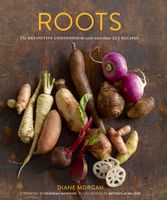Advertisement
History and Lore
By Diane Morgan
Published 2012
The best-known member of the family Dioscoreaceae is the yam, which belongs to the genus Dioscorea. Within the genus are some 150 species, of which 5 domesticated species are important agricultural crops: D. alata and D. esculenta from Southeast Asia; D. opposita from China; and D. rotundata and D. cayenensis from West Africa. The New World also boasts a domesticated species, D. trifida, though it is not widely cultivated. All of these yams, regardless of country or region, are grown in tropical and warm temperate zones. The yam was originally cultivated in Africa, Asia, and the Americas and is thought to have been grown in Asia as early as 4500 B.C. But the yam as a gathered wild food is believed to be significantly older than that. Unlike Peruvian tubers, whose fossilized remains have been carbon-dated, African and Southeast Asian yams have less conclusive data on the age of domesticated plants. Instead, the primary evidence on the history of the yam is linguistic. Such research indicates African yams could be as old as 6000 B.C., though they were probably not cultivated until 1000 B.C.

